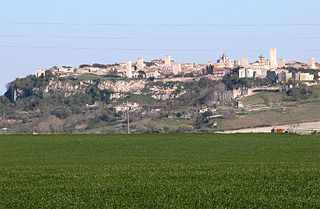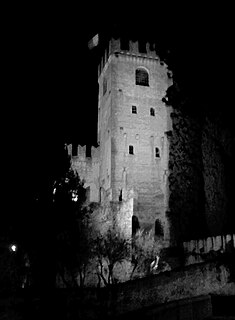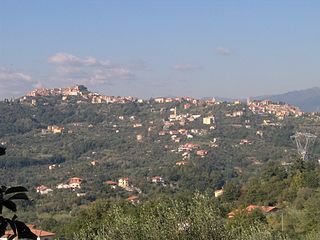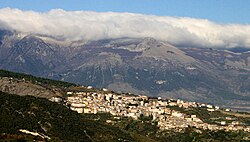
Montalcino is a hill town and comune in the province of Siena, Tuscany, central Italy. It is known for its Brunello di Montalcino wine.

Tarquinia, formerly Corneto, is an old city in the province of Viterbo, Lazio, Italy known chiefly for its ancient Etruscan tombs in the widespread necropoleis or cemeteries which it overlies, for which it was awarded UNESCO World Heritage status.

Manduria is a city and comune of Apulia, Italy, in the province of Taranto. With c. 32,000 inhabitants (2013), it is located 35 kilometres (22 mi) east of Taranto.

Cerignola is a town and comune of Apulia, Italy, in the province of Foggia, 40 kilometres southeast from the town of Foggia. It has the third-largest land area of any comune in Italy, at 593.71 square kilometres (229.23 sq mi), after Rome and Ravenna. In 2017, it had a population of 58,534.

Conegliano is a town and comune of the Veneto region, Italy, in the province of Treviso, about 30 kilometres (19 mi) north by rail from the town of Treviso. The population of the city is of 35,023 people. The remains of a 10th-century castle are situated on a hill that dominates the town. Formerly belonging to the Bishop of Vittorio Veneto, what remains is a bell tower, which now houses a small museum, and outer walls.

Arce is a comune (municipality) in the province of Frosinone, in the region of Lazio, Italy. it is an agricultural centre located on a hill overlooking the Via Casilina, in the Latin Valley and in the middle valley of the Liri.

Greve in Chianti is a town and comune (municipality) in the Metropolitan City of Florence, Tuscany, Italy. It is located about 31 kilometres (19 mi) south of Florence and 42 kilometres (26 mi) north of Siena.

Locorotondo is a town and comune of the Metropolitan City of Bari, Apulia, southern Italy, with a population of about 14,000. The city is known for its wines and for its circular structure which is now a historical center, from which derives its name, which means "Round place". It is located in south-east Murgia, deep in the Itria Valley, dotted with white prehistoric roundhouses called trulli.

Gioia del Colle is a town and comune of the Metropolitan City of Bari, Apulia, southern Italy. The town is located on the Murge plateau at 360 metres (1,180 ft) above sea level. Between Adriatic and Ionian Sea.

Gravina in Puglia is a town and comune of the Metropolitan City of Bari, Apulia, southern Italy.

Taurasi is a town and municipality in the province of Avellino, Campania, southern Italy. In antiquity it was a town in Samnium. The town's name probably derives from the Latin Taurus. Over time it changed from Taurasos to Taurasia(not to be confused with the Taurasia founded in northern Italy by the Taurini, which is now called Turin) before changing to its current form. Taurasi is best known for its increasingly famous red wine also named Taurasi, made of Aglianico grapes along with Piedirosso and Barbera grapes.

Alfano is a village and small comune in the province of Salerno in the Campania region of south-western Italy. As of December 31, 2012, the comune had a population of 1082.

Leverano is a town and comune in the province of Lecce in the southeastern part of the Apulia region of south-east Italy. It is bounded by the comuni of Arnesano, Carmiano, Copertino, Nardò and Veglie.

Breganze is a town in the province of Vicenza, Veneto, Italy. It is northeast of Via Romea. During World War II, the Germans were on one side of the river and the Allies were on the other, and a firefight occurred across the river.

Vezzano Ligure is a comune (municipality) in the Province of La Spezia in the Italian region of Liguria, located about 80 kilometres (50 mi) southeast of Genoa and about 7 kilometres (4 mi) northeast of La Spezia.

Offida is a comune (municipality) in the Province of Ascoli Piceno in the Italian region Marche, located about 80 kilometres (50 mi) south of Ancona and about 12 kilometres (7 mi) northeast of Ascoli Piceno, on a rocky spur between the valleys of the Tesino and Tronto (south) rivers.

Olevano Romano is a comune (municipality) in the Metropolitan City of Rome in the Italian region Latium, located about 45 kilometres (28 mi) east of Rome.
Verdea is a white Italian wine grape variety that originated in Tuscany but is today mainly grown in the Lombardy wine region of northern Italy. The grape is sometimes confused with the white Verdeca grape of the Apulia region and the French wine grape Verdesse from Savoy due to similarities in their names and synonyms. Verdea can be used to make a wide variety of wines, ranging from the late harvested Vin Santo to dry sparkling wines.
Besgano bianco is a white Italian wine grape variety that was historically used in the production of the dessert wine Vin Santo, blended with Malvasia Bianca Lunga and Verdea, but today is rarely planted and is more often used for table grape production than winemaking. The grape is also known as Colombana bianca but it is not a color mutation of the Tuscan and Emilia-Romagna wine grape Colombana nera.
Addoraca is a white Italian wine grape variety that is grown in the Calabria region of southern Italy where it is blended with Coda di Volpe bianca, Malvasia bianca di Candia and Muscat blanc à Petits Grains in the passito dessert wine Moscato di Saracena.
Jevollela, M. 2005, Le radici islamiche dell’Europa, Boroli Editore, Milano.
















